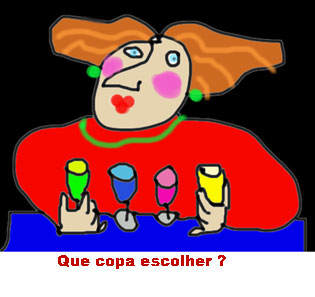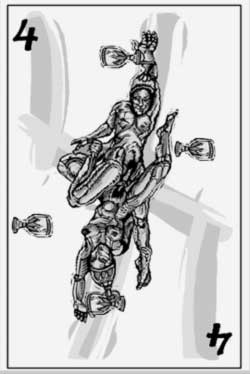
APRIL WEB ARTIST:
MURIEL FREGA / ARGENTINE
1- Small Curriculum:
Born in February 1st, 1972.
Studied at "Manuel Belgrano" and "Prilidiano Pueyrredón" Schools of Fine
Arts, specialized in lithography in a post graduate course.Participates in Mail Art calls, contests and exhibitions of
Ex-libris,Engraving and Drawing, aquiring digital and interactive techniques
since 1997.Works as free lance illustrator.
2- Muriel Frega's Work which is our object of analysis:
System Requirements: Shockwave player, sound
Description:
This project is a simple game, based on the "2 de Copas" Spanish Card, with
some circus influence.
Created in the year 2002, it belongs to a series of erotic cards, conceived
to be engravings. That's the reason why its graphics have xylograph
influence.How to play:
You can choose the number of the card just clicking on it, change the cup's
shape and colour, choosing it from the cup's menu located on the left, and
revert the position of the jugglers, with the orange arrow on the right.
The question mark is a help, in Spanish and English.
To quit the project, click in the arrow located in the lower right margin,
the "salir" arrow.Muriel's URL is also an adress very interesting to browser:
THE FIRST COLLABORATIVE REVIEW
WORK: DOS de Copas / (Two of Copas)
By Muriel Frega
Translation into English by Regina Célia Pinto
English Edition by Joel Weishaus
1- A structure in permanent disequilibrium
"Because when I see you, I wish your wish..."
As soon as we access "DOS de Copas"
(https://archive.the-next.eliterature.org/museum-of-the-essential/museu/artgames.htm) which is in the Museum of the Essential and Beyond That, we have the vision of an old computer (Power Mac Performa 6300 / 160 a.k.a. Performa 6360) with some technical indications. (1). However, what immediately calls our attention is a couple of nude lovers, dolls, reading (?) a book in the foreground. Which book?... Nobody knows, but the dolls are easily identified and certainly made part of the childhood of the girl, Muriel. When we move the mouse over the lovers, to our surprise they turn into another computer image, with more technical indications. About the "more or less" attentive reading of the two lovers, there are no explanations...
After this our attention goes to other points on the screen, and finally reaches two cups, which are the elements that unchain the game that was created in August 2001. The cup on the left starts the game: Is love a game?
The game is a playing card: the "2 of Copas" (hearts), where the "2 of Copas" is represented by a couple of happy lovers involved in an old game of the world. The designer, Muriel Frega, with much competence, used the inverse symmetry of the playing cards to build the lovers and their "game" At the same time in which the couple make love, they practice juggleries with cups, in the way of circus jugglers. The number of cups can be enlarged when we click on the numerals of the cards. The couple can love happily and play four cups at the same time! There are four different kinds of cups on the left side of the screen. The player (us) can also choose which of them we want to play.
Also, there are some arrows (right side, bottom) which when clicked alternate the lovers' positions: the one who is on the bottom goes to the top and the lover who is on the top goes to the bottom. It happens without stopping the juggleries! Funny!
""I want to be on your body as a tattoo.
It is to give you courage
For following your trip...
When the night comes...
I want to play on your body like a ballerina
Who hallucinates
Jumps and illuminates you
When the night comes..."
(fragment of "Tattoo" - Ruy Guerra and Chico Buarque, English version: Regina Célia Pinto)Muriel Frega's game with a few elements tells a lot about the relationship between man and woman, and it reveals, with a sense of humor, that "Love is the only structure in permanent disequilibrium."
"Dos de Copas" (Two of Copas) also reminds me the work of Lygia Clark 1920 - 1988), a well-known Brazilian artist who also worked on the issue of body, Eros and Thanatos, opening, certainly, the way for Muriel Frega, who was born in 1972.LLygia Clark elaborated the "Roupa Corpo Roupa " (Clothes Body Clothes), a series of interactive clothing that tried to establish a contact between the two sexes through the man's discovery of himself in the woman, and vice-versa. The first of that series was called "I and You", and consisted of two sets of clothing linked with an umbilical cord. When opening the zippers of their partner's clothes, man and woman are surprised to find their own body in the partner's body..
Clothing elaborated by Lygia had a function opposite from habitual clothes. Instead of covering and protecting the body, they were made to unveil it. The body transformed the individual's conscience in face / mask imposed by the society. Clothes are a mediator between society and nature. With them, the social imposition of the "I" gives a place to the restrained nature. The individual as a social being also gives a place to an anonymous being. Hidden in the "Clothes Body Clothes", he/she escapes from the determination
of the group. A thick plastic barrier encourages the touch and allows the individual to
keep contact with other forces, normally contained, especially those always found in the relationship man/woman, the contradictory forces of Love and Death, Eros and Thanatos.
Fearing this after life that is not more life, but which is Death, human beings of our society start to fear death and accept the life that is imposed to them. So that they are transformed into beings incapable of offering their lives to themselves, incapable of running the risk of dying. Incapable of living, because not wanting to die and not wanting to live are the same thing. Incapable of living, because there is only one way not to die: to be already dead. (2)
To compare the works of Lygia Clark and Muriel Frega is to observe a little bit the masculine / feminine relationship in art through time. I felt it would be interesting to show this to you.
To conclude, I also would like to recommend that you browse the latest work of another excellent artist who is part of our list: Annie Abrahams
Annie Abrahams - http://www.bram.org/pain
There you will find a very poetic work that is among other things also involved with masculine/feminine relationships. I am sure that you will give much time to browsing this work.
Notes
1. "Dos de Copas" (Two of Copas) was prepared by Muriel Frega for the attic of the Museum of the Essential and Beyond That and because of this it has this introduction with the computers.
2. Rodrigues, José Carlos. "The taboo of the death". Rio de Janeiro, Achiamé, 1983, P. 283.
2- Dos de Copas / Two of Copas // Roles, Sex & Tech
The peculiar thing of "2 de Copas" is how two different images are complemented to speak of the same subject and about other subjects not enunciated. Like in the binomial of Duchamp the "Mariée... / Étant Donnés" (The Large Glass), each one of them complements the other. The evidently associated sex-game seems to me more perverse and revealing in that it seems more innocent: Naked Barbie and Ken reading a magazine on a PC.
The great success of the Barbie is based on an inversion of papers: the doll no longer represents the fictitious daughter of the girl, but the girl as a project. It is not a repository, but a carefully articulated model of life through its complements, that is in fact the fundamental grammar of Barbie's speech, in which Ken is only another complement. One of the most persistent axioms of this speech is its noticeable sexual component. Its anthropometric model would correspond to a girl in the middle of her development, with her strange proportions neither of girl nor of woman. Whoever coexists with girls of that age knows the sexual soup that they cook at this stage.
Returning to Ken, the man-object Ken, I insist that it is no more than another complement of the Barbie girl-project. An evidently sexual complement (the fiancé, a "Duchampian" fiancé, perpetually celibate). All hacker versions of the doll that I have seen insist the same: they try to turn it into a species of satanic vixen, to give it back to the category of woman-object. They have not noticed that the most disturbing part of Barbie's universe is indeed the submissive and consoling smiling which is named Ken.
Muriel Frega Muriel Frega shows all of this: Naked Barbie and Ken, sharing the reading of a magazine. If we know something about this couple, we know who has chosen the reading. It does not matter what they are reading, but that, whatever it is, is pleasurable. Thus the reading acquires a sexual component: a preface.
On the other hand, the scenery contributes a new sense to the word "technofilia". It turns the PC into a symbolic nuptial thalamus. It is not an absolutely dangerous appreciation: an important part of the bits that circulate from PC to PC through the Internet as sexual content, until for many people Internet and pornography are almost synonymous, an object of many hysterias.
... and also in the traditional sense there is a certain "technofilia" composing this double piece, if I do not interpret it poorly... In fact, the part which seems the most revealing to me is low-tech (the dolls). Although the game of cards also contains interesting playful-erotic keys..
I say that the game of cards is less disturbing because it alludes to strip poker, which is an adult game. The symmetry grants a regime of equality to both lovers, just like the rotation of positions (the classic interchange ' now you are above '). The alcohol, represented by the multitude of changing glasses, is the aphrodisiac par excellence, and the numbers... they indicate the number of 'assaults'? (or of games, not leaving the semantic field: or of an octopus, speaking clearly).
This piece is more elaborated, but is also more descriptive, less allusive, less mysterious. Nevertheless, the juxtaposition of the two pieces enriches both. It offers a double point of view on a same subject (a stereoscopic vision, that contributes depth): the apparent innocence with the pump of the dolls versus real innocence, by the explicitness of cards..
Muriel Frega opens a subject here that can be completed: the different relations between sex and game through the stages of development of the individual, through the cultures, the religions...
An opened work, really, that suggests interesting arguments.
Comments and Conclusion
I would like to add these paragraphs to this collaborative review based on Muriel Frega's work. I think they complement both Smirnoff's and my review:
Marcel Mauss, in the communication about " body technicals" says the importance of a rigorous study on the fact that each society imposes on the individual a deliberated use of the body. He establishes that it is through education that the children are exercised, learning to dominate reflexes, inhibiting their fears and selecting their gestures. For this eminent anthropologist, the physical education of all ages and of the two sexes is replete of particulars that need to be observed. Beauvoir wrote: - Nobody is born a woman, but becomes a woman. I would like to complete this with: Nobody is born a man, but becomes a man.
Which man? Which woman? This depends on the society and the time that we are
or were observing.
In what way are men and women coexisting today in cyberspace?... Hidden in the anonymous world of Internet chats, they can interpret multiple roles...In the simulated worlds of 3D, "avatars" walk unworriedly, being able to live life as a romance, or to make of it a work of art, or a stage of violence and authoritarianism.
We have narrowed the gap between fantasy world and reality. [. . .]. The border is no longer real.
What about the posthuman being? According to Haraway, "cyborg arises a political dimension while locating in the women a bigger aptitude to deal with the innovations of the cyberculture. Women are more accustomed to the small one, to the domestic - the house will be the new locus of the work - but mainly they escape of the masculine domination vices: individualism, hegemony, selfishness."[2]
Is it preferable to be a cyborg or to be a goddess? ... Or, best of all, is the game/ relation man-woman which is revealed through the work "Dos of Copas" by Muriel Frega: "a structure in permanent disequilibrium"?
However, Hayles ( "How we Became Posthuman, Virtual Bodies in CybernetcsLiterature and Informatics" -1999) affirms that, in the
autumn of the liberal humanist citizen, the posthuman citizen begins to wake, "an amalgam, a collection of heterogeneous components, a material entity - informational whose borders are submitted to the continuous construction and reconstruction." Will this be for better or for worse?... the transformation into the posthuman will annihilate the subject? Will individual action and wish will be possible in the future? Will there be a "Self " to be recognized? (p.281) "[ 3} We can presuppose that there still will be a body; in this case, how will it be? It will continue as we know it now, masculine and feminine? Or, thinking about Baudrillard and cloning, will the human body be only one? In this case, masculine or feminine ? Would we be on the threshold of the infinite survival of the similar creature - the "death of Thanatos"?... Then, what about Eros?...
 |
|
Which
should I choose?
|
| Paulo Villela / 2004 |
[1] MAUSS, Marcel apud LÉVI-STRAUSS, Claude. Ensaio sobre a dádiva. Introdução de Claude Lévi-Strauss. Lisboa, Edições Setenta, 1988, p.11.
[2], [3] SANTOS, Jair Ferreira dos. Breve, o Pós-Humano. Rio de Janeiro, Livraria Francisco Alves Editora, 2003, p. 63, p.73.
4- Another Opinion (Edited by Millie Niss)
By Joesér Alvarez
When looking at Muriel Frega' s images lacking clothes and emotion, we see an explicit and pornographic voyeurism much more than eroticism: expressions of plastic bodies, mechanic sexuality. The hints: the cadenced music, the pure rub of sexes, simulated sexual intercourse. What do the numbers suggest? Do they suggest a variation around the axis of the minimal possibilities for such acts? Does the game involve money?
If the game tells us something, it tells how we recognize ourselves in some of those moments, man / woman: roles socially constituted. Sometimes, looking at the center of the image, it seems that there are two vaginas: woman / woman: homosexuality. These are also socially constituted roles and genders, but never assumed as such, denied by the affirmation of a certain nature, of a look: the look of capitalist rationality, the look which penetrates and wants to devour everything - the look of Western rationality.
The erotic practice, celebrated by cinema and romances: the sexual intercourse on the table, among dishes or on the desk, among papers and books, it represents the insipidity of the machine, in Muriel Frega's work, a double transgression: the suggestion of sexuality in the objects of childhood and the simulation of the mechanical sexuality. Eros or Pornos? Suggestion or simulation? Where the boundary? The images are an invitation to reflect on this.
Muriel Frega´s work also refers to another work which participated of the exhibition E.M.O.Ç.Ã.O. A.R.T.I.F.I.C.I.A.L. (Artificial Emotion), at ITAÚ Cultural, where two three-dimensional androids, projected in a dark room, copulated mechanically and with rhythm (making sounds of Uhs! and Ahs!), changing their position as the spectator moved the mouse, in an infinite metamorphosis based on the mechanichal skin underneath the human being's skin.
I do not know if the posthumans bodies will have this mechanical appearance (it is difficult to think that something done by man could be more frightful and full of virus than its own species ) but evidently many of pre / posthuman species, have the same rhythm (suggested in that work) combined with the lack of emotion that Muriel Frega's work seems to suggest as allegory. The interfaces of these programs and the pieces of these games, show the pornography and the capitalist rationale which is so latent in our inability to see our bodies as we move.
Dante Smirnoff, Joesér Alvarez and Regina Célia Pinto have done an analysis of the work "Dos de Copas" by Muriel Frega, which exhausts the subject. I can add nothing, only to agree and to point out a strong graphic appeal -- a stimulant -- which is tasty and funny for the observer.
5- Paulo Villela's comment
